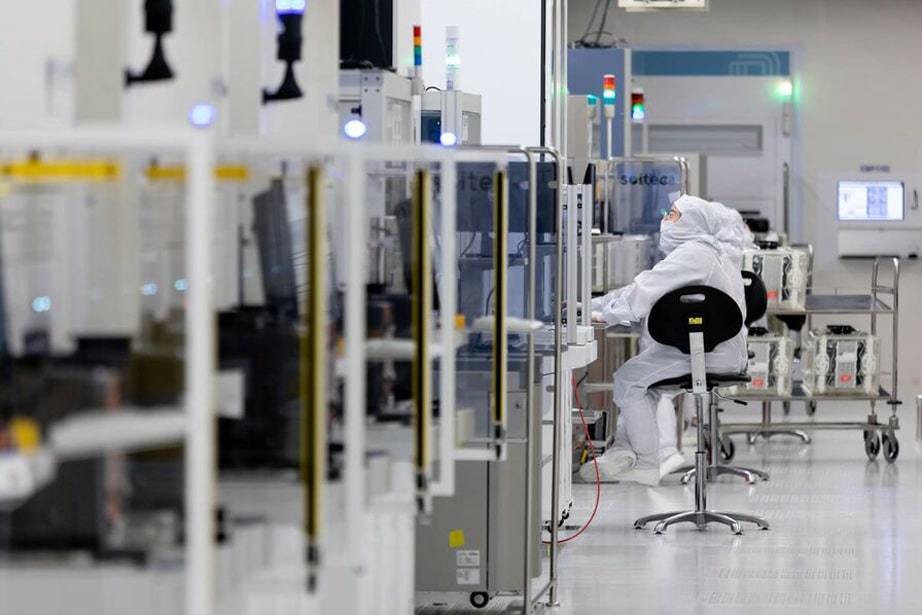
May 21, 2025
Discover the Essential Role of Cleanrooms in Modern Manufacturing
Cleanrooms form the foundation of industries where environmental stability is non-negotiable. Whether you’re producing sensitive pharmaceuticals or precision semiconductors, our engineered cleanrooms maintain the exacting controls necessary to preserve product integrity and regulatory compliance.
Safeguarding Your Production Processes
In industries such as biopharmaceuticals, aerospace, and high-tech electronics, even minuscule contaminants can disrupt process efficiency and compromise quality. Our facilities use high-efficiency particulate air (HEPA) filtration, rigorously managed airflow, and strict access controls to ensure that all environmental parameters consistently meet the demands of ISO 14644, GMP, and FDA 21 CFR Part 11 standards.
Elevating Product Quality and Compliance
A meticulously designed cleanroom minimizes contamination risks to guarantee that every production run is defect-free. Our systems not only satisfy but exceed the air cleanliness and environmental monitoring requirements required by global standards. With continuous particle monitoring and precision airflow management, our cleanroom environments help safeguard your production pipelines and maintain competitive excellence.
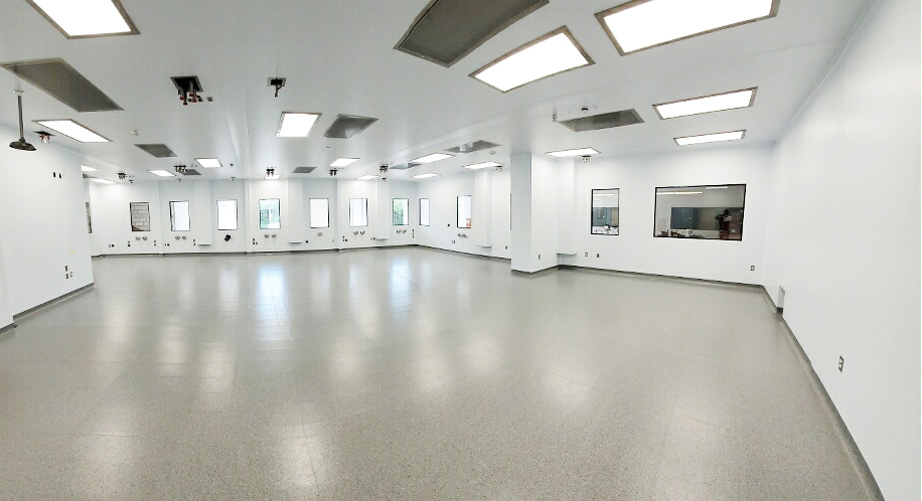
Sectors Benefiting from Our Solutions
- Pharmaceutical & Biotech: Enabling aseptic processing and sterile drug production to support cell & gene therapy.
- Semiconductor & Microelectronics: Facilitating the fabrication of microchips and sensors with unmatched precision.
- Aerospace & Defense: Ensuring contamination-free assembly for satellites, avionics, and propulsion systems.
- Medical Devices: Creating sterile settings for the production of implantable devices and surgical instruments.
G-CON’s Modular Cleanroom Advantage
Traditional cleanroom construction demands lengthy build times and extensive infrastructure. Our G-CON modular cleanrooms—including standardPOD, mobilisPOD, and megaPOD configurations—offer a fully prefabricated, rapidly deployable alternative that seamlessly integrates with your existing facilities or stands alone. With pre-engineered designs, factory acceptance testing (FAT), and swift on-site installation, our systems empower your organization to achieve full operational readiness in a fraction of the time, reducing both risk and cost.
Explore how G-CON’s modular solutions can transform your manufacturing capabilities, ensuring elevated compliance, efficiency, and scalability in a dynamic market.
How Cleanrooms Maintain Air Quality
Our cleanroom solutions achieve uncompromised air quality through state-of-the-art filtration and meticulous environmental controls. By employing advanced HEPA and ULPA filters within unidirectional laminar airflow systems, our facilities actively expel airborne particles and secure an environment where every production detail is safeguarded.
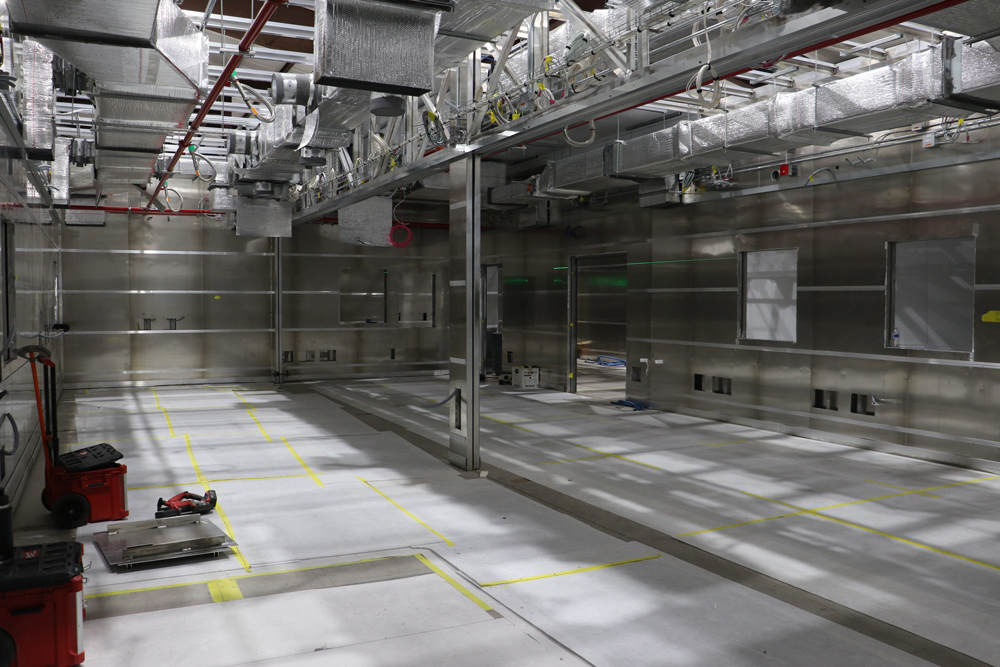
Advanced Filtration Technologies
In our modular cleanrooms, pre-installed HEPA filters capture 99.97% of particles above 0.3 microns while ULPA filters deliver even higher efficiency, removing 99.9995% of particles above 0.12 microns. These robust systems renew a constant flow of purified air, ensuring that your manufacturing processes remain pristine and compliant.
Comprehensive Contamination Controls
We regulate air quality by directing controlled, unidirectional airflow to minimize turbulence and isolate critical zones. Positive pressure environments ward off external contaminants, while strategically managed negative pressures support specialized containment needs. Additionally, rigorous material handling and personnel protocols—enforced through strict gowning procedures and air showers—further reduce particulate intrusions.
Dynamic Environmental Monitoring
Continuous monitoring through integrated Building Management Systems (BMS) and Environmental Monitoring Systems (EMS) provides real-time feedback on particle counts and microbial levels. Such active surveillance ensures adherence to ISO 14644-1 classifications and meets demanding GMP and FDA 21 CFR Part 11 standards without compromise.
G-CON’s Modular Advantage
Our standardPOD, mobilisPOD, and megaPOD configurations incorporate advanced HVAC solutions and automated monitoring, enabling rapid, scalable deployment. By uniting cutting-edge filtration with modular design, we deliver turnkey cleanroom environments that preserve product integrity and elevate operational readiness.
Understanding Cleanroom Classifications
Our cleanrooms are engineered to control airborne particles with precision. We adhere to international standards such as ISO 14644 and pharmaceutical GMP guidelines, which rigorously define environmental parameters for industries like biopharma, semiconductors, and aerospace.
ISO 14644 – Defining Air Cleanliness
ISO 14644-1 establishes limits for airborne particle concentration, categorizing environments from ISO Class 1 to ISO Class 9. For instance, ISO 5 environments—ideal for aseptic processing and semiconductor lithography—allow a maximum of 3,520 particles (≥0.5µm) per cubic meter. In contrast, ISO 7 and 8 settings serve pharmaceutical compounding and general manufacturing, respectively.
| ISO Class | Max Particles (≥0.5µm/m³) | Typical Application |
|---|---|---|
| ISO 5 | 3,520 | Aseptic processing, lithography |
| ISO 7 | 352,000 | Pharmaceutical compounding |
| ISO 8 | 3,520,000 | General production |
GMP Standards in Cleanroom Design
Guidelines such as EU GMP Annex 1 and FDA 21 CFR Part 211 delineate critical environments — Grade A, B, C, and D — to control microbial and particulate risks. For example, Grade A is synonymous with critical aseptic filling zones, while Grades B through D accommodate less critical stages in production.
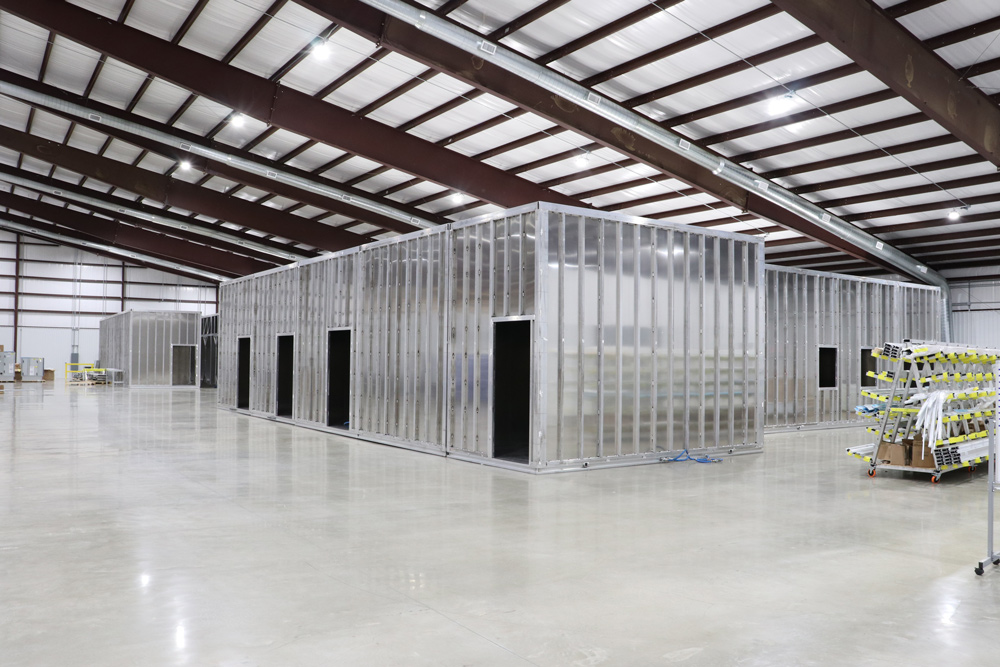
G-CON Modular Compliance
Our standardPOD, mobilisPOD, and megaPOD solutions integrate advanced HEPA filtration, robust environmental monitoring, and automated contamination control. This design ensures rapid deployment, scalable integration, and strict adherence to ISO and GMP requirements.
Key Industries and Applications of Cleanrooms
Our cleanroom solutions are engineered to secure production integrity and regulatory compliance for high-stakes manufacturing. By maintaining controlled environments that eliminate airborne contaminants, we ensure precision and efficiency in every process.
Industries Benefiting from Our Cleanroom Technologies
Pharmaceutical & Biotech
Our controlled spaces enable aseptic drug production, support advanced cell and gene therapy environments, and allow personalized compounding—all without compromise.
Semiconductors & Microelectronics
Eliminating particulates is critical during wafer fabrication, sensor production, and microchip assembly. Our systems maintain sub-micron tolerances required in lithography and packaging operations.
Aerospace & Defense
Protecting sensitive electronic assemblies and structural components is essential. Our cleanroom conditions are designed to safeguard satellite assembly, avionics production, and high-performance propulsion processes.
Medical Devices
We create environments that ensure absolute sterility for implantable devices, surgical instruments, and diagnostic equipment, thereby upholding the highest standards of patient safety.
Advantages Across Sectors
Our facilities comply with ISO 14644, GMP, and FDA 21 CFR Part 11 standards. They actively control particles, microbes, and environmental fluctuations, streamlining production and minimizing delays.
G-CON’s Modular Edge
G-CON’s modular cleanrooms—including standardPOD, mobilisPOD, and megaPOD—are prefabricated, rapidly deployable, and scalable. Our plug-and-play POD systems integrate seamlessly with existing infrastructures or operate independently, delivering cost-effective and compliant environments tailored to your organization’s needs.
Benefits of Implementing Cleanrooms in Manufacturing
Enhancing Quality and Process Reliability
Our cleanroom environments secure every production process by rigorously controlling airborne particles and maintaining precise airflow. These spaces uphold strict air cleanliness and environmental stability, ensuring that product integrity is never compromised. By meeting ISO 14644, GMP, and FDA 21 CFR Part 11 requirements, our controlled environments protect sensitive productions in pharmaceuticals, biotechnology, semiconductors, and aerospace.
Streamlined Regulatory Compliance
When regulatory bodies such as the FDA, EMA, and WHO demand robust contamination control, our modular cleanrooms deliver. Designed to provide a validated, controlled atmosphere, G-CON’s standardPOD, mobilisPOD, and megaPOD are built for rapid deployment while aligning with global compliance benchmarks. This approach minimizes risks related to non-compliance, product recalls, and regulatory penalties—ensuring your organization consistently meets the most demanding industry standards.
Optimized Operational Efficiency
Enhanced environmental control translates to smoother workflows and lower downtime. Our pre-assembled cleanroom systems integrate automated environmental monitoring, high-performance HEPA filtration, and real-time air quality tracking to maintain consistent production conditions. The modular design facilitates scalability, allowing you to expand or reconfigure spaces quickly as production demands shift.
Long-Term Cost Savings and Sustainable Operation
Our modular approach replaces lengthy construction timelines and high capital expenditure. Factory-assembled and pre-validated, our cleanrooms are deployed within months, reducing both initial investment and ongoing maintenance costs. Energy-efficient HVAC systems and optimized airflow management lower operational expenses while supporting compliance with ISO 50001 energy standards.
The G-CON Advantage for Your Organization
By adopting our modular cleanrooms, your organization secures a future-proof, compliant solution that enhances product quality, streamlines operations, and offers flexible scalability—all while reducing risk and ensuring sustainable growth.
Challenges and Considerations in Cleanroom Design
Designing a cleanroom demands precise coordination of contamination control, regulatory adherence, and operational efficiency. Achieving uniform laminar airflow remains essential; misdirected flows can result in particle build-up that undermines sterility. Compliance with ISO 14644, GMP, and FDA 21 CFR Part 11 requires rigorous environmental validation and comprehensive documentation, while careful material selection ensures surfaces resist microbial growth and remain easy to maintain.
Integrated solutions address these challenges effectively. Our pre-validated modular systems—encompassing standardPOD, mobilisPOD, and megaPOD configurations—offer plug-and-play environments that combine high-efficiency HEPA filtration, unidirectional airflow, and automated pressure balancing. Real-time monitoring through advanced Building Management Systems (BMS) and Environmental Monitoring Systems (EMS) provides continuous oversight of air quality, temperature, and humidity, thereby facilitating proactive compliance and energy optimization.
Sustainability is inherent in our approach. Energy-efficient HVAC systems, smart automation, and LED lighting reduce operational costs while preserving cleanroom integrity. Regular validation through particle counting, airflow assessments, and microbial monitoring—complemented by scheduled maintenance and personnel training—ensures long-term reliability and consistent performance.
Collectively, these strategies empower your organization to maintain production integrity and regulatory excellence, transforming cleanroom design challenges into opportunities for operational advancement.
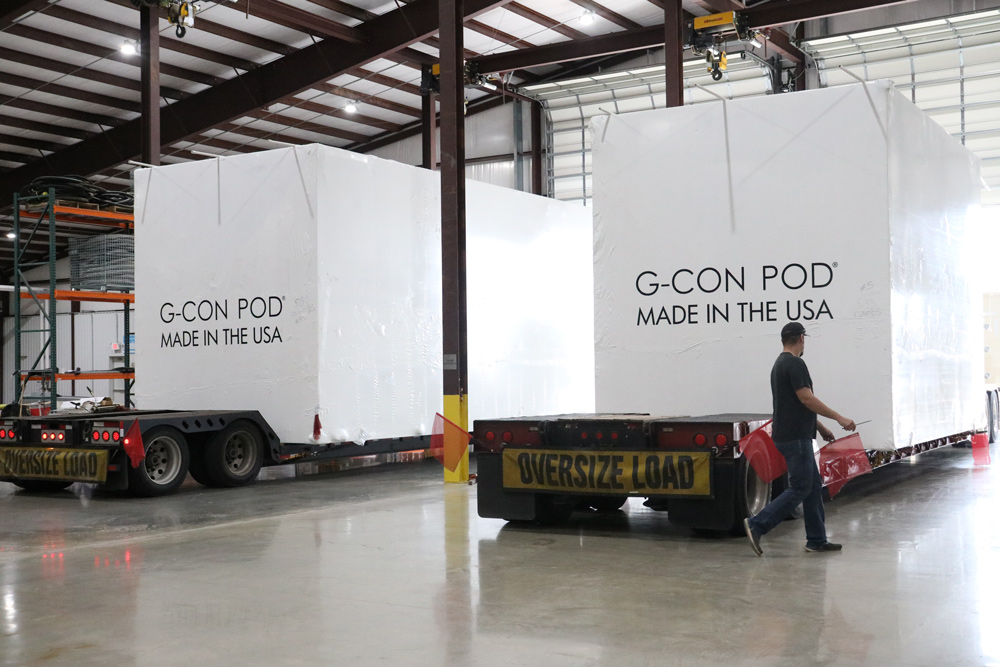
Innovations and Future Trends in Cleanroom Technology
Modular Cleanrooms: Redefining Scalable Manufacturing
G-CON transforms manufacturing by replacing fixed, lengthy builds with pre-engineered cleanroom modules. Our standardPOD, mobilisPOD, and megaPOD systems offer factory-built, pre-validated units that cut installation time dramatically. These adaptive modules empower your organization to expand or reconfigure spaces seamlessly while meeting stringent ISO 14644, GMP, and FDA 21 CFR Part 11 standards. Benefits include rapid deployment, operational scalability, and precise environmental control built into every unit.
Smart Cleanrooms: Integrating Automation and Real-Time Control
Advanced Building Management and Environmental Monitoring Systems continuously track temperature, humidity, and particulate levels. Smart sensors actively regulate airflow and pressure, ensuring consistent contamination control. AI-driven analytics underpin predictive maintenance, mitigating system failures and minimizing downtime. Through remote monitoring and adaptive environmental adjustments, our smartPOD offers a dynamic, data-informed approach to operational excellence.
Sustainable Design and High-Bay Efficiency
Energy-efficient HVAC systems optimize power usage without compromising air quality. Our designs incorporate streamlined airflow management and sustainable materials that reduce waste while adhering to ISO 50001 energy management standards. High-bay configurations and integrated multi-unit systems provide the vertical and horizontal space needed for large-scale bioprocessing and advanced manufacturing, making our solutions ideal for specialized applications such as cell therapy, aseptic processing, and semiconductor fabrication.
Contact G-CON Today for Expert Cleanroom Solutions
At G-CON, we redefine industry standards with our modular cleanroom systems. Our advanced standardPOD, mobilisPOD, and megaPOD configurations are engineered to accelerate your project timeline and seamlessly integrate with any facility. We deliver turnkey, factory-tested units that meet the strict requirements of ISO 14644, GMP, and FDA 21 CFR Part 11.
Experience a solution that maximizes process integrity and operational efficiency. Our prefabricated cleanrooms combine efficient HEPA and ULPA filtration with intelligently controlled airflow and environmental monitoring. Designed for rapid installation, our systems significantly reduce the time from concept to operational readiness, ensuring you stay ahead in competitive manufacturing environments.
Our integrated approach offers:
- Verified regulatory compliance for streamlined qualification and risk mitigation
- Swift, modular deployment that adapts easily to evolving production demands
- Dynamic automation through advanced Building Management and Environmental Monitoring Systems that provide real-time performance tracking
- Cost-effective infrastructure that minimizes capital expenditure and lowers ongoing maintenance expenses
We understand that your organization’s success relies on uncompromised performance and scalable design. Our cleanroom solutions support diverse sectors—from pharmaceuticals and biotechnology to semiconductors and aerospace—enhancing production quality while maintaining strict environmental controls.
Reach out to our team of cleanroom specialists to discover how our innovative, modular designs transform manufacturing processes. Contact us to explore tailored solutions that drive efficiency, offer flexible growth, and secure compliance with global standards.
Frequently Asked Questions
What Are the Essential Elements of a Cleanroom?
Essential elements include advanced air filtration systems with HEPA filters that eliminate 99.97% of particles (≥0.3 microns) and ULPA filters achieving 99.9995% efficacy for particles (≥0.12 microns). Precise environmental conditioning controls temperature, humidity, and pressure differentials. Robust contamination control includes unidirectional airflow, strict gowning protocols, secure airlocks, and continuous environmental monitoring systems. All designs adhere to ISO 14644-1 and stringent GMP guidelines.
How Do Cleanrooms Meet Regulatory Requirements?
Our cleanrooms integrate advanced air filtration and real-time monitoring to uphold ISO 14644, GMP, and FDA 21 CFR Part 11 standards. We employ pre-installed HEPA filters, automated environmental monitoring through integrated Building Management and Environmental Monitoring Systems, validated protocols through rigorous Factory Acceptance Testing, and strict personnel management through gowning and entry protocols.
What Are the Financial Implications of Cleanroom Installation?
G-CON’s modular cleanrooms dramatically reduce financial burden by cutting installation timelines from 12-24 months to just 3-6 months. Initial setup costs are significantly reduced compared to traditional construction, with streamlined validation through Factory Acceptance Testing and designed-for-expansion scalability. Ongoing maintenance focuses on filtration & HVAC, environmental monitoring, training & supplies, and energy management.
How Do Cleanrooms Enhance Product Quality?
Cleanrooms actively eliminate contaminants through advanced HEPA and ULPA filtration systems, maintaining ISO 14644-compliant air quality. Robust environmental management stabilizes manufacturing conditions through controlled temperature, humidity, and pressure differentials. This results in improved process reliability, enhanced batch consistency, reduced likelihood of costly recalls, and streamlined regulatory approval processes.
How Do Cleanrooms Support Environmental Sustainability?
Our modular cleanrooms harness advanced HEPA filtration, variable-speed air handling, and smart environmental monitoring to drastically reduce energy consumption. Off-site prefabrication reduces material waste by up to 30%, while reusable components and recyclable filters significantly diminish disposable waste. Factory-assembled cleanrooms lower on-site construction emissions and offer reduced carbon footprint from start to finish.
How Are Cleanrooms Tailored to Industry Needs?
We craft environments with optimized airflow patterns, precision HEPA and ULPA filtration systems, controlled pressure settings, superior non-shedding materials with antimicrobial coatings, and integrated automation with real-time monitoring. Industry-specific requirements include ISO 5-7 standards for pharmaceutical applications, electrostatic discharge management for semiconductors, vibration isolation for aerospace, and sterile packaging protocols for medical devices.
